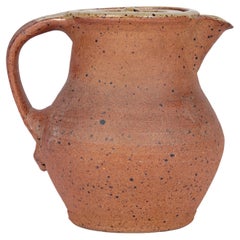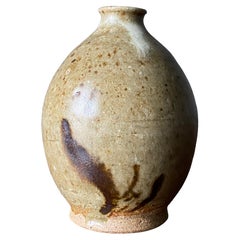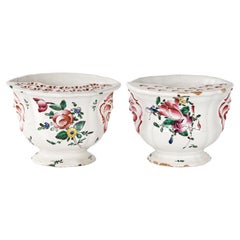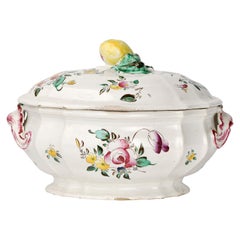Glazed Ceramics
19
to
19
19
19
19
606
552
454
164
99
72
50
24
19
19
13
12
7
1
1
19
19
19
19
19
19
9
7
1
Style: Rococo
Technique: Glazed
Ancient Italian Maiolica Tureen, Rubati Manufacture, Milan, circa 1770-1780
Located in Milano, IT
Maiolica tureen
Pasquale Rubati Manufacture
Milan, circa 1770 - 1780
Maiolica polychrome decorated “a piccolo fuoco” (third fire).
It measures 6.69 in x 11,02 x 8.26 (17 x 28 x ...
Category
1770s Italian Rococo Antique Glazed Ceramics
Materials
Maiolica
Ancient Italian Coffee Pot, Coppellotti Manufacture, Lodi, Circa 1740
By Antonio Maria Coppellotti
Located in Milano, IT
Coffee pot
Antonio Maria Coppellotti Manufacture
Lodi, Circa 1740
High fire polychrome maiolica
It measures: 7.87 in x 6,49 x 5.11 (20 cm x 16,5 x 13); weight 1.23 lb (561 g)
...
Category
1730s Italian Rococo Antique Glazed Ceramics
Materials
Maiolica
Small Maiolica Flower Pots, Ferretti Manufacture, Lodi, circa 1770-1780
Located in Milano, IT
Two maiolica flower pots
Antonio Ferretti Manufacture
Lodi, Circa 1770 - 1780
Maiolica polychrome decorated “a piccolo fuoco” (third fire)
The...
Category
1770s Italian Rococo Antique Glazed Ceramics
Materials
Maiolica
Ancient Italian Assortment Coffe Pot and Cups, Lodi, Circa 1765-1770
Located in Milano, IT
A coffee pot and two cups with saucers
Antonio Ferretti Manufacture
Lodi, Circa 1765-1770
Maiolica polychrome decorated “a piccolo fuoco” (third fire).
They measure:
coffee pot: 9....
Category
1760s Italian Rococo Antique Glazed Ceramics
Materials
Maiolica
18th Century, Italian Maiolica Flower Pot, Pasquale Rubati, Milan, 1770 circa
Located in Milano, IT
Maiolica flower pot “a mezzaluna”
decorated with trompe l’oeil
Pasquale Rubati Factory
Milan, 1770 circa
It measures: 4.7 in (cm 12) X 5 in (...
Category
1770s Italian Rococo Antique Glazed Ceramics
Materials
Maiolica
Italian Maiolica Ancient Sugar Bowl, Lodi, 1770-1780
Located in Milano, IT
Maiolica sugar bowl
Antonio Ferretti Manufacture
Lodi, Circa 1770-1780
Maiolica polychrome decorated “a piccolo fuoco” (third fire).
It measures 3.54 x 4.52 x 3.54 in (9 x 11,5 x 9 cm)
Weight: 0.394 lb (0.179 kg)
State of conservation: small and slight chips on the edges.
The small sugar bowl has a swollen and ribbed body resting on a flat base. The cap-shaped lid follows the rib of the container and is topped with a small knob in the shape of a two-colored fruit.
The sugar bowl is painted “a piccolo fuoco” (third fire) with the characteristic floral motif of bunches and isolated semis.
An example which closely corresponds to this one is kept at the Civic Museum in Lodi (G. Gregorietti, Maioliche di Lodi, Milano e Pavia, Catalogo della Mostra, Milano, 1964 n. 137).
This decorative style represented a strong point of the Lodi factory, which established itself thanks to the vivid nature of the colors made possible by the introduction of a new technique perfected by Paul Hannong in Strasbourg and later introduced by Antonio Ferretti to Italy. The production process, called “piccolo fuoco” (third fire), allowed the use of a greater number of colors than in the past; in particular, the purple of Cassius, a red made from gold chloride, was introduced. Its use allowed for many more tones and shades, from pink to purple.
The Ferretti family started their maiolica manufacturing business in Lodi in 1725.
The forefather Simpliciano started the business by purchasing an ancient furnace in 1725 and, indeed, we have evidence of the full activity of the furnaces starting from April of the same year (Novasconi-Ferrari-Corvi, 1964, p. 26 n. 4). Simpliciano started a production of excellence also thanks to the ownership of clay quarries in Stradella, not far from Pavia. The production was so successful that in 1726 a decree of the Turin Chamber came to prohibit the importation of foreign ceramics, especially from Lodi, to protect internal production (G. Lise, La ceramica a Lodi, Lodi 1981, p. 59).
In its initial stages, the manufacture produced maolicas painted with the “a gran fuoco” (double fire) technique, often in turquoise monochrome, with ornamentation derived from compositional modules in vogue in Rouen in France. This was also thanks to the collaboration of painters like Giorgio Giacinto Rossetti, who placed his name on the best specimens next to the initials of the factory.
In 1748 Simpliciano made his will (Gelmini, 1995, p. 30) appointing his son Giuseppe Antonio (known as Antonio) as universal heir. After 1750, when Simpliciano passed away, Antonio was directly involved in the maiolica factory, increasing its fortunes and achieving a reputation on a European level. Particularly important was the aforementioned introduction in 1760 of the innovative “a piccolo fuoco” (third fire) processing, which, expanding the ornamental repertoire with Saxon-inspired floral themes, was able to commercially compete with the German porcelains that had one of its most renowned offerings in the naturalistic Deutsche Blumen. Antonio Ferretti understood and promoted this technique and this decoration, proposing it in a fresher and more corrective version, less linked to botanical tables, both with or without contour lines, as well as in purple or green monochrome. After efforts to introduce more industrial production techniques to the sector succeeded, even the Ferretti manufacture, in the last decade of the eighteenth century, started heading towards decline despite its attempts to adapt production to neoclassical tastes.
In 1796 the Napoleonic battle for the conquest of the Lodi bridge over the Adda definitively compromised the furnaces. Production resumed, albeit in a rather stunted manner, until Antonio's death on 29 December 1810. (M. L. Gelmini, pp. 28-30, 38, 43 sgg., 130-136 (for Simpliciano); pp. 31 sgg., 45-47, 142-192 (for Antonio).
Bibliography
G. Gregorietti, Maioliche di Lodi Milano e Pavia Catalogo della Mostra, Milano, 1964 n. 137;
C. Baroni, Storia delle ceramiche nel Lodigiano, in Archivio storico per la città e i comuni del circondario e della diocesi di Lodi, XXXIV (1915), pp. 118, 124, 142; XXXV (1916), pp. 5-8;
C. Baroni, La maiolica antica di Lodi, in Archivio storico lombardo, LVIII (1931), pp. 453-455;
L. Ciboldi, La maiolica lodigiana, in Archivio storico lodigiano, LXXX (1953), pp. 25 sgg.;
S. Levy, Maioliche settecentesche lombarde e venete, Milano 1962, pp. 17 sgg.;
A. Novasconi - S. Ferrari - S. Corvi, La ceramica lodigiana, Lodi 1964, ad Indicem; Maioliche di Lodi, Milano e Pavia (catal.), Milano 1964, p. 17;
O. Ferrari - G. Scavizzi, Maioliche italiane del Seicento e del Settecento, Milano 1965, pp. 26 sgg.;
G. C. Sciolla, Lodi. Museo civico, Bologna 1977, pp. 69-85 passim; G. Lise, La ceramica a Lodi, Lodi 1981;
M. Vitali, in Storia dell'arte ceramica...
Category
1770s Italian Rococo Antique Glazed Ceramics
Materials
Maiolica
Italian Maiolica Cup Ferretti Lodi, circa 1770 - 1780
Located in Milano, IT
Maiolica puerperal cup
Antonio Ferretti Manufacture
Lodi, Circa 1770 - 1780
Maiolica polychrome decorated “a piccolo fuoco” (third fire).
It measures: 4.3 x 6.8 x 5.3 in (11 x 17,5 x 13,5 cm)
Weight: 0.78 lb (358 g)
State of conservation: some closed pass-through fêlures on the cup, barely visible on the outside. Some use chips on the edge of the lid, two of which are more marked.
From about the mid-sixteenth century, the puerperal soup tureen or puerperal cup became one of the most popular wedding gifts in central Italy. As an auspicious symbol, it replaced the birth table (“desco da parto”) which, on the occasion of high-ranking marriages, from the thirteenth century, had been painted by famous artists, especially in Tuscany.
In France this same tureen is called "écuelle de mariée", as it is given to spouses as a sign of fertility.
During the eighteenth century this custom spread even outside Italy to all social levels. Depending on availability and rank, it was made of different materials: precious metals, maiolica, porcelain, glass, pewter, etc.
Beginning in the mid-twentieth century, the custom of this symbolic homage gradually disappeared, although famous designers such as Gio Ponti and Giuseppe Gariboldi, even as recently as the 1940s, revisited a model of a small puerperal soup bowl for the Ginori and, also in Italy in 1940, in a national competition for young potters, one of the themes of the test was indeed a modern model of a puerperal cup as an auspicious gift.
This particular cup was also called a "service cup" or "puerperal vase" or "stuffed cup" - the windows were sealed with straw to prevent drafts of air for women in labor.
In the eighteenth century the line of the puerpera cup was simplified, so much so that it took the form of a small tureen with two handles - the typical broth cup...
Category
1770s Italian Rococo Antique Glazed Ceramics
Materials
Maiolica
Ancient Maiolica Coffee Set “Barbotine” Decoration Milan, 1770- 1780
Located in Milano, IT
Coffee assortment with “barbotine” decoration
Manufacture of Pasquale Rubati or Felice Clerici
Milan, 1770- 1780
Maiolica polychrome decorated “a piccolo fuoco” (third fire).
...
Category
1770s Italian Rococo Antique Glazed Ceramics
Materials
Maiolica
Ancient Maiolica Cup, Rubati Manufacture, Milan, Circa 1770 - 1780
Located in Milano, IT
Sick cup
Pasquale Rubati Manufacture
Milan, Circa 1770 - 1780
Maiolica decorated in polychrome “a piccolo fuoco” (third fire)
It measures: h 2.36 x 7.4 x 7.87 (h 6 x 19 x 20 cm)
...
Category
1770s Italian Rococo Antique Glazed Ceramics
Materials
Maiolica
Maiolica Oval Tray, Felice Clerici Manufactory, Milan, Circa 1770-1780
Located in Milano, IT
Small oval tray
Felice Clerici Manufactory 1745-1780
Milan, Circa 1770-1780
Maiolica polychrome.
Dimensions: 10.82 x 8.66 in (27.5 x 22 cm); weight 0.4...
Category
1770s Italian Rococo Antique Glazed Ceramics
Materials
Maiolica
Ancient Maiolica Dishes with flowers, Lombard Manufacture, 1770-1780 Circa
Located in Milano, IT
Assortment of dishes
Lombard manufacture
1770 – 1780 Circa
Maiolica polychrome decorated “a piccolo fuoco” (third fire).
Two large dishes: diameter 14.76 in (37.5 cm); weight 4.5...
Category
1770s Italian Rococo Antique Glazed Ceramics
Materials
Maiolica
Maiolica Italian Pitcher Ferretti Manufacture, Lodi Circa 1770 - 1780
Located in Milano, IT
Maiolica pitcher
Antonio Ferretti Manufacture
Lodi, circa 1770-1780
Maiolica polychrome decorated “a piccolo fuoco” (third fire).
It measures 8.66 x 8.66 x 4.33 in (22 x 22 x 11 ...
Category
1770s Italian Rococo Antique Glazed Ceramics
Materials
Maiolica
Italian Maiolica Ancient Tureen, Lodi, 1770-1780
Located in Milano, IT
Maiolica tureen
Antonio Ferretti Manufacture
Lodi, circa 1770-1780
Maiolica polychrome decorated “a piccolo fuoco” (third fire).
It measures 9.05 x 12.59 x 9.05 in (23 x 32 x 23 cm)
...
Category
1770s Italian Rococo Antique Glazed Ceramics
Materials
Maiolica
Antique Italian Maiolica Coolers Pasquale Rubati Manufacture Milan, 1770 Circa
Located in Milano, IT
Assortment of bottle and glass coolers in Maiolica.
Pasquale Rubati manufacture
Milan, circa 1770
Maiolica polychrome decorated “a piccolo fuoco” (third fire)
a - Bottle cooler
5.91 in x 5.91 in diameter (15 x 15 cm )
Weight: 1.86 lb (845 g)
b - Bottle cooler
6.89 x 7.87 in diameter (17,5 x 20 cm)
Weight: 2.09 lb (948 g)
c - Pair of glass-cooler vases
3.94 x 3.94 in diameter (10 x 10 cm)
Weight: 1.43 lb (650 g)
Good state of conservation:
a - some chipping from use on the edge;
a - two fêlures covered on the edge;
c - one has deep chippings on the edge and the other a subtle fêlure.
Two Majolica factories were active in Milan in the 18th century. The first, starting from 1745, was owned by Felice Clerici; the other one by Pasquale Rubati from 1756. Rubati was in competition with Felice, whose worker he had been prior to opening his own workshop. On his death in 1796, the business was continued for a few more years by his son Carlo.
Recent studies have recognized Pasquale Rubati's contribution as the creator of "Strasbourg-style" decorations with their particularly joyful depictions. This style had previously been attributed to the Lodi manufacturers. These works here, however, are a clear example of this production.
The Majolica containers have different sizes, a cylindrical shape and rest on a low foot ring. The two largest are completed by handles in the shape of a zoomorphic mask with wide open jaws, while the smaller ones have handles applied with an anthropomorphic mask.
All the works are characterized by elegant floral decoration.
The two twin glass coolers show bunches of flowers centered around a main corolla, a rose or a peony paired...
Category
1770s Italian Rococo Antique Glazed Ceramics
Materials
Maiolica
Pair of Italian Maiolica Tureens, Ferretti Manufacture, Lodi Circa 1770 - 1780
Located in Milano, IT
Pair of maiolica tureens
Antonio Ferretti Manufacture
Lodi, circa 1770-1780
Maiolica polychrome decorated “a piccolo fuoco” (third fire).
a – 8.66 x 11.02 x 7.48 in (22 x 28 x 19...
Category
1770s Italian Rococo Antique Glazed Ceramics
Materials
Maiolica
Ancient Maiolica Plates Pasquale Rubati, Milan Circa 1770-1780
Located in Milano, IT
Five oval maiolica dishes with pierced edge
Manufacture of Pasquale Rubati
Milan, 1770-1780
Three small oval dishes 10.23 in x 7.67 in (26 cm x 19.5 cm)
Two large oval dishes 10.82 in x 8.85 in (27.5 x 22.5 cm)
lb 3.5 (kg 1.8)
State of conservation: intact
The five dishes of different sizes have an oval shape, a mixtilinear edge and a molded polylobed shape with a surface enriched with a relief weave motif extending to the brim and forming a perforated basket...
Category
1770s Italian Rococo Antique Glazed Ceramics
Materials
Maiolica
Italian Maiolica Service Pasquale Rubati Milano with Green Flowers, circa 1780
Located in Milano, IT
Assortment of 21 maiolica service elements
Pasquale Rubati Factory
Milan, 1780 circa
a. Four large oval dishes or fish dishes 10.43 in x 21.25 in (26.5 c...
Category
1770s Italian Rococo Antique Glazed Ceramics
Materials
Maiolica
Ancient Italian Maiolica Rose Dishes by Pasquale Rubati Milano, 1780 circa
Located in Milano, IT
Assortment of 12 elements with polychrome and gold decoration
Pasquale Rubati Factory
Milan, circa 1770- 1790.
Two oval trays 10.62 in x 8.58 in (27 x 21.8 cm)
Two dishes with perf...
Category
1770s Italian Rococo Antique Glazed Ceramics
Materials
Maiolica
Ancient Italian Maiolica Flower Pots, Pasquale Rubati Factory, Milan 1770 circa
Located in Milano, IT
Maiolica flower pot “a mezzaluna”
Pasquale Rubati Factory
Milan, 1770 Circa
They measure: height 6.2 in x 8.66 x 5.31 (15,8 cm x 22 x 13,5)
Weigh...
Category
1770s Italian Rococo Antique Glazed Ceramics
Materials
Maiolica
Related Items
Bernard Leach Midcentury Studio Pottery Ash Glazed Coffee Pot
Located in Bishop's Stortford, Hertfordshire
A stylish midcentury ash glazed handcrafted Studio Pottery coffee pot by renowned English potter Bernard Leach CBE (British, 1887-1979) and made at ...
Category
20th Century English Mid-Century Modern Glazed Ceramics
Materials
Stoneware
Studio Pottery Weed Pot, circa 1975
Located in Costa Mesa, CA
Studio Pottery weed pot / vase. circa 1975.
Category
20th Century American Mid-Century Modern Glazed Ceramics
Materials
Ceramic
Spanish Painted Terracotta Bowl
Located in Los Angeles, CA
Stunning terracotta bowl from Spain, 1960's. Beautiful blue and green painted detail with etched fish design and etched wavy edge detailing. Great vintage condition. Can be hung on a...
Category
Mid-20th Century French Glazed Ceramics
Materials
Ceramic
Pair of Glazed Ceramic Flower Vases by Delphin Massier, France, circa 1890
Located in Buenos Aires, Buenos Aires
Pair of glazed ceramic flower vases by Delphin Massier, France, circa 1890.
Category
Late 19th Century French Art Nouveau Antique Glazed Ceramics
Materials
Ceramic
H 29.93 in W 10.24 in D 9.06 in
Majolica Brown Rabbit Tureen Caugant
Located in Austin, TX
French Majolica rabbit tureen signed Caugant, circa 1940.
Category
1950s French Country Vintage Glazed Ceramics
Materials
Ceramic, Faience, Majolica
Italian Oggetti Porcelain Pheasant Soup Tureen with Ladle
By Oggetti
Located in Los Angeles, CA
Italian hand painted Porcelain pheasant soup gravy tureen with ladle by Oggetti. A cleaver soup or gravy tureen covered by a hand painted bird like form. A wonderful piece for sharin...
Category
20th Century Italian Glazed Ceramics
Materials
Porcelain, Ceramic
Majolica Doe Tureen Caugant, circa 1950
Located in Austin, TX
Rare Majolica doe tureen signed Caugant, circa 1950.
Category
1950s French Country Vintage Glazed Ceramics
Materials
Ceramic
French Green Majolica Tureen with Stand Sarreguemines, circa 1870
Located in Austin, TX
19th Century green Majolica tureen with stand signed Sarreguemines Majolica, circa 1870
With grapes leaves.
Height / 7.5", diameter / 8 inches.
Category
1870s French Victorian Antique Glazed Ceramics
Materials
Faience, Majolica, Ceramic
Minton Majolica Small Jardinière Flower Trough Singed, Dated 1871
By Minton
Located in Banner Elk, NC
Minton Majolica Small Jardiniere, realistically molded as a simulated water trough formed by faux wooden staves and pegs, overlain with budding Hawthrone branches, the corners formed as mossy posts, banded near the base with pegged logs, the interior glazed in Minton Blue (turquoise); impressed marks to reverse: 'MINTON,' with British Registry Number for 16 April 1870 (when the design was registered), Minton date cipher for 1871, and the Design Number, '1563,' which corresponds to the entry, 'FLOWER TROUGH...
Category
19th Century English Victorian Antique Glazed Ceramics
Materials
Majolica
Enamel Ceramic Flower Vase Signed Saint Clement, France, circa 1930
Located in Buenos Aires, Buenos Aires
Enamel ceramic flower vase signed Saint Clement. Art Deco period, France, circa 1930.
Category
Mid-20th Century French Art Deco Glazed Ceramics
Materials
Ceramic
Regency Period Derby Cup and Saucer Duo Hand Painted, Circa 1830
Located in Lincoln, Lincolnshire
This is a beautiful porcelain duo of a cup and saucer by the Derby factory, made during the late Georgian, Regency period of the first half of the 19th century, circa 1830
The han...
Category
Early 19th Century British Regency Antique Glazed Ceramics
Materials
Porcelain
Samson Porcelain Armorial Cup and Saucer in Chinese Taste, Paris, Circa 1870
By Edmé Samson
Located in Lincoln, Lincolnshire
This is a very good fluted porcelain armorial tea cup and saucer in the Chinese taste with an Armorial lion and horse supporting a shield above a legend, made by Samson, Paris, France.
Edme Samson, Paris, circa 1860 - 1880. EdmeSamson of Paris (1810-1891) was one of the foremost copyists of Chinese porcelain and nowadays his copies are treasured in the own right for the quality of their craftsmanship and skill in painting, as with this piece.
This piece is beautifully made with lavish bianco-sopra-bianco, enamel and gilt decoration. The cup has a Heraldic Coat of Arms on the front in the style of Chinese Export porcelain with a lion and horse supporting a red shield...
Category
19th Century French Antique Glazed Ceramics
Materials
Porcelain
Previously Available Items
Pair of Italian Maiolica Flower Pots, Antonio Ferretti, Lodi, circa 1770 – 1780
Located in Milano, IT
Pair of flower pots
Antonio Ferretti Manufacture
Lodi, circa 1770 – 1780
Maiolica polychrome decorated “a piccolo fuoco” (third fire)
They meas...
Category
1770s Italian Rococo Antique Glazed Ceramics
Materials
Maiolica
H 4.73 in W 6.7 in D 5.71 in
Italian Ancient Maiolica Tureen, Lodi, 1770-1780
Located in Milano, IT
Maiolica tureen
Antonio Ferretti Manufacture
Lodi, Circa 1770 - 1780
Maiolica polychrome decorated “a piccolo fuoco” (third fire).
It measures 7.48 x 7.48 x 11.02 in (19 x 19 x 2...
Category
1770s Italian Rococo Antique Glazed Ceramics
Materials
Maiolica
Dozen Blue and White Creamware Dinner Plates Made 20th Century
Located in Katonah, NY
This set of a dozen blue and white Septfontaines creamware dinner dishes was made by Boch Luxembourg in the 20th century. The dishes show a delicate sprig pattern which has remained ...
Category
20th Century Luxembourgish Rococo Glazed Ceramics
Materials
Creamware
Salt-Glazed Dish Made in England, circa 1765
Located in Katonah, NY
We are excited to be offering this exceptional salt-glazed stoneware fruit dish. Made circa 1765, this elaborately pierced dish was usually placed on the table with salt-glazed baske...
Category
Mid-18th Century English Rococo Antique Glazed Ceramics
Materials
Stoneware
Antique Creamware Figure of a Fox, 18th Century
Located in Katonah, NY
A late 18th century small creamware figure of a fox pressed out in a mold and hollow on the inside in the 18th century creamware style. Made in England, circa 1790. We can see the br...
Category
Late 18th Century English Rococo Antique Glazed Ceramics
Materials
Creamware
Antique Creamware Dogs Made by Nove di Bassano Made in Italy circa 1820
Located in Katonah, NY
We are pleased to offer this pair of wonderful Antique Creamware Dogs Made by Nove di Bassano. These creamware poodles were made in Italy in the first quarter of the 19th century. Ea...
Category
Early 19th Century Italian Rococo Antique Glazed Ceramics
Materials
Creamware
Recently Viewed
View AllMore Ways To Browse
Italian Glazed Pottery Bird
Gustavsberg Horse
Minton Pedestal
Salt Glaze Dishes
Vallauris Fish Plates
Vintage Stoneware Mug
Vintage Stoneware Mugs
16th Century Renaissance Italy Majolica
Compagnie Des Indes
Lettuce Leaf
Vintage Ceramic Cooking Pots
Retro White Ironstone
Royal Doulton Arts And Crafts
Stoneware Limoges
Ashworth China
Blue Dragon Pot
Ground Squirrel
Japanese Stoneware Plate



